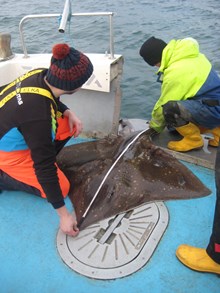07 June, 2016
World’s largest skate and small shark followed in new west coast tagging study
High-tech tracking devices are helping scientists to protect two of Scotland’s most endangered fish species in a west coast Marine Protected Area (MPA).
Marine biologists from Scottish Natural Heritage (SNH) and Marine Scotland Science (MSS) are working together, with help from local creel fishermen and anglers, to better understand how common skate and spurdog use the Argyll MPA.
The Loch Sunart to the Sound of Jura MPA is designated to help protect the common skate, the world’s largest skate species. Skate are related to sharks and common skate can grow up to two metres across and three metres long. The project team have fitted tags to 40 skate caught in the area, the largest of which weighed an impressive 98kgs.
The area is also a hotspot for spurdog, sometimes known as spiny dogfish, a small shark which grows up to 1.5 metres long. Eight spurdog have been tagged so far and more tagging is planned for the summer.
Both species were once common in Scottish waters but have suffered large declines in population numbers and, now considered to be vulnerable, are included on Scotland’s list of Priority Marine Features for conservation action. The tagged fish were photographed for future identification and a DNA sample was taken for analysis, before being quickly released.
Dr Jane Dodd, who is managing the project for SNH, said: “We’re really lucky in Scotland to have a wonderful range of wildlife living in our seas. Previous studies have shown that common skate are resident in the waters off Oban in significant numbers and the MPA was designated for their protection in 2014. By tracking skate in the MPA we aim to better understand how they use the area throughout the year, which will help us to make sure that the management of the site is appropriate.”
Two types of tags are being used in the project. Acoustic tags communicate with receivers positioned in the Sound of Mull, the Firth of Lorn, Loch Linnhe, the Lynn of Lorn and Loch Etive, which record each time an individual fish passes within range.
Dr James Thorburn, MSS Fish Tracking Officer, said: “Some of the skate are also fitted with Data Storage Tags (DSTs), which record the depth and water temperature every two minutes. DSTs provide more detail about where the fish are spending their time in the MPA, allowing us to recreate their movements.”
Spurdog are generally thought to be a migratory species, travelling over large distances. However, studies have shown that some spurdog remain in Loch Etive throughout the winter.
James said: “There is some evidence that spurdog breed in Loch Etive. The tagging work will improve our understanding about the number of fish that move in and out of the loch, or remain there year round.”
The equipment used in the project is also providing opportunities to learn about other species. Marine Scotland has tagged salmon smolts leaving the Rivers Lochy and Awe that will be detected by the same receivers. And the Scottish Association for Marine Science (SAMS) is listening for harbour porpoise clicks with equipment attached to some of the receiver moorings.
Jane said: “This exciting project has brought together a range of people who all want to see these fantastic fish thrive in Scotland’s seas. We are particularly grateful to the creelmen who are helping us to maintain the moorings and collect the data from the receivers. And to the anglers who have shared their skate and spurdog data with us and are returning the DSTs to us. Whilst we want the black acoustic tags to stay on the fish for the duration of the project,1 year, we need to retrieve the white DSTs to access the information on them and we will be very happy to receive these after the end of June. There is a £50 reward for each of the DSTs returned to us.”
For more information about the project, including a ‘reward poster’ with photos of the tags, visit the SNH website - http://www.snh.gov.uk/skate-spurdog-tracking
The common skate is the largest skate in the World - it can reach a length of 2.5 m and weigh over 100 kg (that’s 15 stone!). It can be found in waters ranging from 10 - 600 m deep. It has no bones; rather, like other sharks, skates and rays, it has a cartilage skeleton. Skates are an ancient group of fish that first appeared in fossil records about 150 million years ago.
Spurdog are small, graceful sharks which were once abundant in Scottish waters. Found mainly in coastal and shelf waters in depths of 10-200 metres, although they can be found up to 900 metres below the surface. The UK population is estimated to have declined by 95%.
More information on the Loch Sunart to the Sound of Jura MPA is available on our website here.
More information on Scotland’s Priority Marine Features is available on our website here.
More information on Scotland’s MPA network is available on our website here.
Contact information
- Name
- SNH Media
- snhmedia@snh.gov.uk
NatureScot is Scotland's nature agency. We work to enhance our natural environment in Scotland and inspire everyone to care more about it. Our priority is a nature-rich future for Scotland and an effective response to the climate emergency. For more information, visit our website at www.nature.scot or follow us on X at https://x.com/NatureScot
’S e NatureScot buidheann nàdair na h-Alba. Bidh sinn a’ neartachadh àrainneachd na h-Alba agus a’ brosnachadh dhaoine gu barrachd suim a chur ann an nàdar. Tha e mar phrìomhachas againn gum bi nàdar na h-Alba beairteach agus gun dèilig sinn gu h-èifeachdach le èiginn na gnàth-shìde. Tha an tuilleadh fiosrachaidh aig www.nature.scot no air X aig https://x.com/NatureScot

